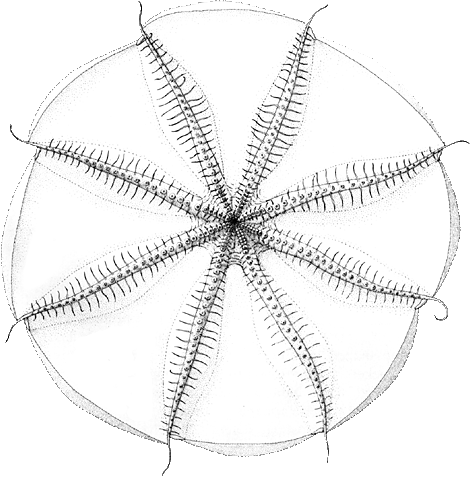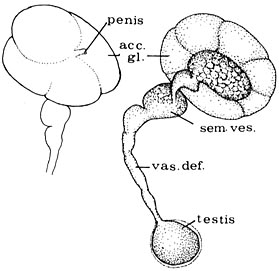- Arms
- Arms subequal.
- Arm tips bare.
- Suckers terminate where web joins arm on distal dorsal margin.
- Cirri terminate at last sucker.
- Most of arm with secondary web; secondary web on ventral side of arm terminates at nodule.
- Ventral web nodule at level of 3rd or 4th distal normal sucker.
- Suckers small: Suckers 2 and 3 usually largest then gradually decrease to sucker 7 or 8.
- 7 or 8 proximal suckers cup-shaped, usually raised on broad, heavy stalks; following suckers less than half diameter of proximal suckers, delicate with thin infundibulum and often with no apparent acetabulum, stalks large, fluid-filled, delicate; distal to about sucker 28, suckers normal.
- Largest distal sucker about equal to proximal suckers in diameter.
- Cirri small between suckers 1 and 3; largest at midarm (19 mm long, 9-13 times diameter of largest sucker).
 Click on an image to view larger version & data in a new window
Click on an image to view larger version & data in a new window
Figure. Oral view of arms and web of C. muelleri. Drawing from Voss and Pearcy, 1990.
- Gills
- Gills sepioid in appearance.
- Gills with 7-8 primary lamellae on each demibranch.
- Male reproductive system
- Penis small.
- Accessory gland complex a compact, flattened oval structure.
- Female reproductive system
- Proximal oviduct ca. 4-5 times length of distal oviduct.
- Oviducal gland dark colored; distal portion much larger than proximal portion.
- Largest ovarian egg 10.4 x 9.3 mm.
- Beaks
- Thin, weak.
- Pigmentation
- Pale white to purple (in ethanol).
- Inner surfaces of arms and web darkest, purple or purplish-brown.
- Measurements and counts (Males, Min.-(Mean)-Max.)
- Mantle length: 53-(69.5)-79.
- Mantle width: 26-(35.0)-47.
- Head width: 32-(38.8)-52.
- Arm length, arm I: 145-170.
- Arm length, arm II: 140-178.
- Arm length, arm III: 170.
- Arm length, arm IV: 170.
- Total length:178-(221.8)-177.
- Fin length: 47-(49.3)-53.
- fin width: 21-(26)-30.
- Sucker diameter: 1-(1.5)-2.1.
- Cirrus length: 11.0-(16.2)-19.2.
- Number of gill lamellae: 7-(8)-9.
- Measurements and counts (Females, Min.-(Mean)-Max.)
- Mantle length: 40-(58.6)-67.
- Mantle width: 19-(33.3)-46.
- Head width: 21-(35.0)-47.
- Arm length, arm I: 96-114.
- Arm length, arm II: 96.
- Arm length, arm III: 94.
- Arm length, arm IV: 67-(97)-124.
- Total length:113-(169.2)-203.
- Fin length: 41-(50.4)-61.
- fin width: 18-(29.4)-38.
- Sucker diameter: 0.6-(1.4)-2.4.
- Cirrus length: 8.0-(13.9)-19.2.
- Number of gill lamellae: 7-(7.6)-8.
Measurements are taken from Voss and Pearcy, 1990
Comments
The description of C. muelleri presented here, except for the gill, was taken from Voss and Pearcy (1990) which was based on North Pacific specimens. O'Shea (1999) describes a specimen from off New Zealand that has an arm sucker count of 33-39 which appears to be within the range of the North Pacific specimens. Although Voss and Pearcy didn't provide sucker counts, the web nodule lies at sucker 31 or 32 and additional suckers are present up to the junction of the dorsal web to the arms. O'Shea described the optic stalk complex of his specimen. The optic lobe was spherical; a single optic nerve bundle penetrated a spherical white body.








 Go to quick links
Go to quick search
Go to navigation for this section of the ToL site
Go to detailed links for the ToL site
Go to quick links
Go to quick search
Go to navigation for this section of the ToL site
Go to detailed links for the ToL site